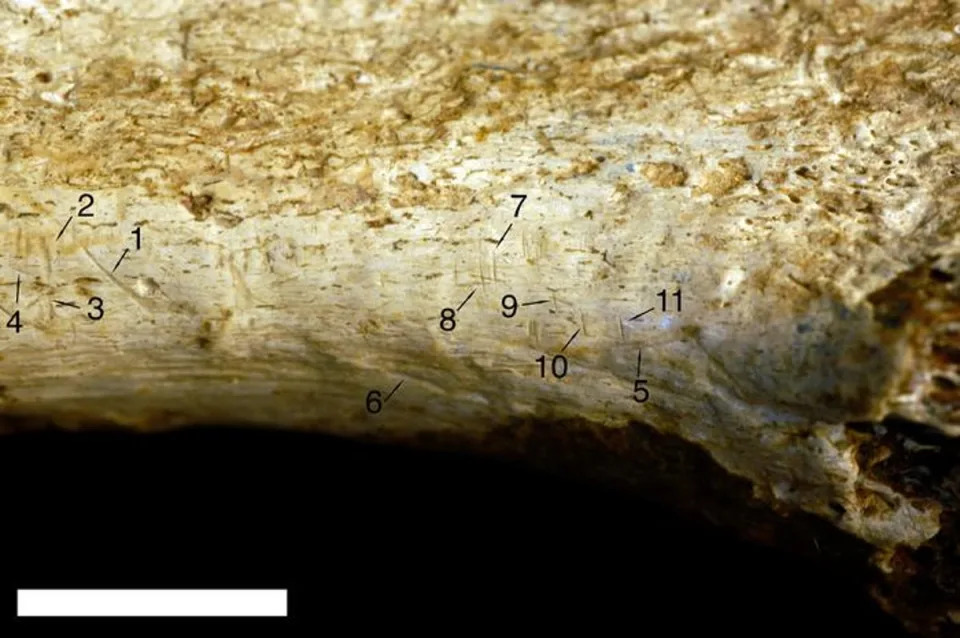Scientists find cannibal human ancestor species that likely butchered and ate each othe
Vishwam Sankaran
Tue, 27 June 2023

Scientists have identified the oldest evidence hinting at cannibalism in humans’ close relative species who likely butchered and ate each other.
The study published on Monday in the journal Scientific Reports, assessed nine cut marks on a 1.45 million-year-old left shin bone from a relative of modern humans found in northern Kenya.
Researchers, including those from the Smithsonian’s National Museum of Natural History in the US, say the cut marks seem to have been caused due to damage inflicted by stone tools.
They say this could be the oldest instance of cannibalism in a human relative species known with a high degree of confidence and specificity.
“The information we have tells us that hominins were likely eating other hominins at least 1.45 million years ago,” study co-author Briana Pobiner said.
“There are numerous other examples of species from the human evolutionary tree consuming each other for nutrition, but this fossil suggests that our species’ relatives were eating each other to survive further into the past than we recognized,” Dr Pobiner said.
Researchers first came across the fossil shin bone in the collections of the National Museums of Kenya’s Nairobi National Museum while looking for clues about which prehistoric predators might have been hunting and eating humans’ ancient relatives.
When looking at the shin bone for bite marks from extinct beasts with a handheld magnifying glass, Dr Pobiner instead noticed what immediately looked to her like evidence of butchery.
She then sent molds of the cuts made with the same material dentists use to create impressions of teeth.
Researchers then created 3D scans of the molds and compared the shape of the marks to a database of 898 individual tooth, butchery, and trample marks created through controlled experiments.
Scientists could positively identify nine of the 11 marks as clear matches for the type of damage inflicted by stone tools and the other two as likely bite marks from a big cat.
While the cut marks by themselves do not prove that the human relative who inflicted them may have also made a meal out of the leg, Dr Pobiner suspects this was the most likely scenario.
She says the cuts are located on the shin where a calf muscle would have attached to the bone – a good place to cut if the goal is to remove a chunk of flesh.
The marks were also found to be all oriented in such a way that a hand wielding a stone tool could have made them all in succession without changing grip or adjusting the angle of attack.
“These cut marks look very similar to what I’ve seen on animal fossils that were being processed for consumption. It seems most likely that the meat from this leg was eaten and that it was eaten for nutrition as opposed to for a ritual,” Dr Pobiner said.
However, scientists say there is not enough evidence to conclusively infer this as a sign of cannibalism as that would require the eater and the eaten to hail from the same species.
While the fossil bone is known to be that of a human relative species, experts say there is not enough information to assign the specimen to a particular species of hominin.
They say the use of stone tools also does not narrow down which species might have been doing the cutting.
Some researchers have further called into question the once-common assumption that only one genus, Homo, made and used stone tools.
While this fossil evidence may be a trace of prehistoric cannibalism, it is also likely that this may have been a case of one human ancestor or relative species chowing down on a cousin species.
It is also hard to infer anything about the order of events that took place based on the bite marks, researchers say.
They say a lion may have scavenged the remains after hominins removed most of the meat from the leg bone or alternatively a big cat that killed an unlucky hominin was likely chased off before opportunistic hominins took over the kill.
However, the findings underscore the value of museum collections, researchers say.
No comments:
Post a Comment